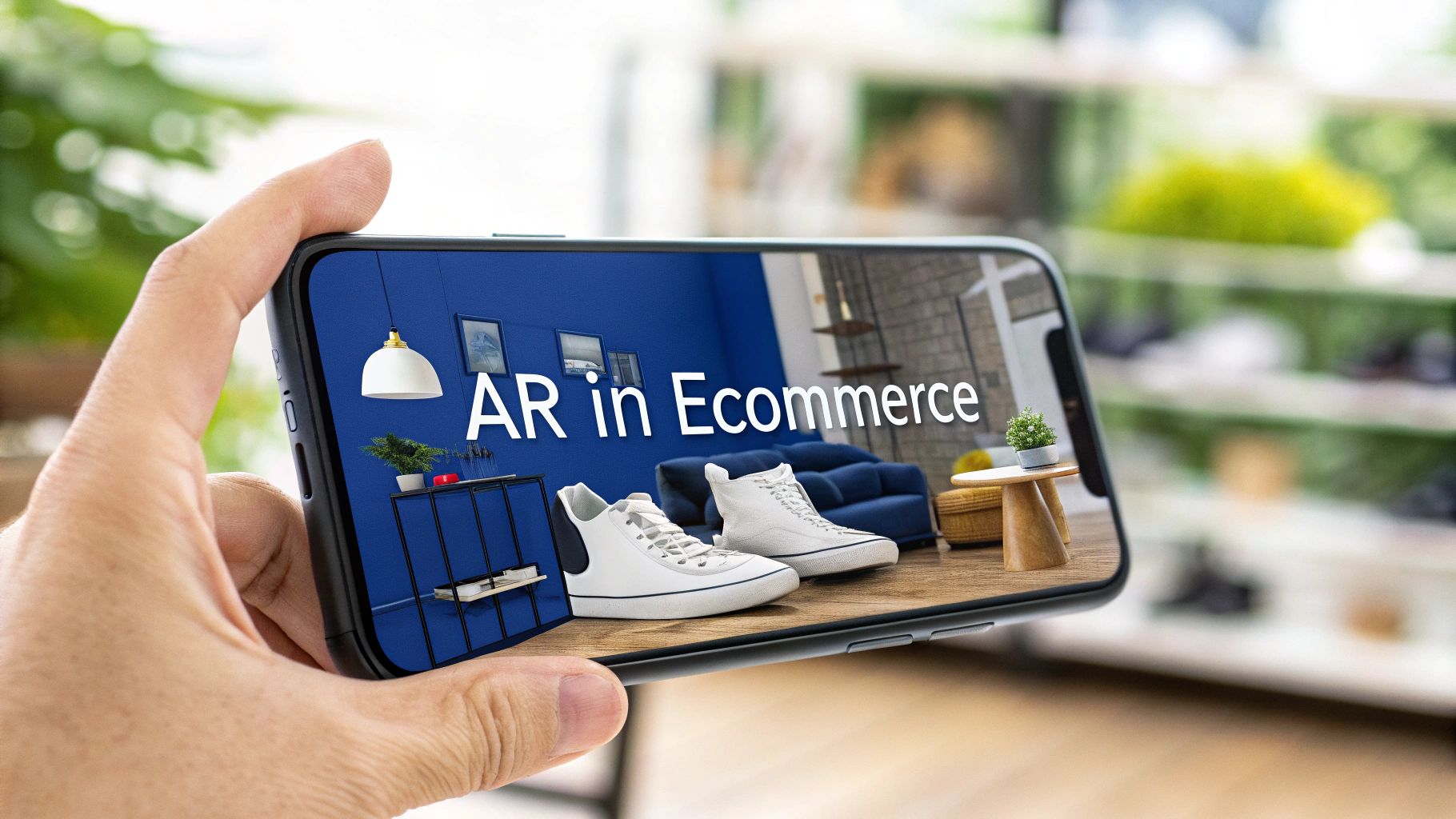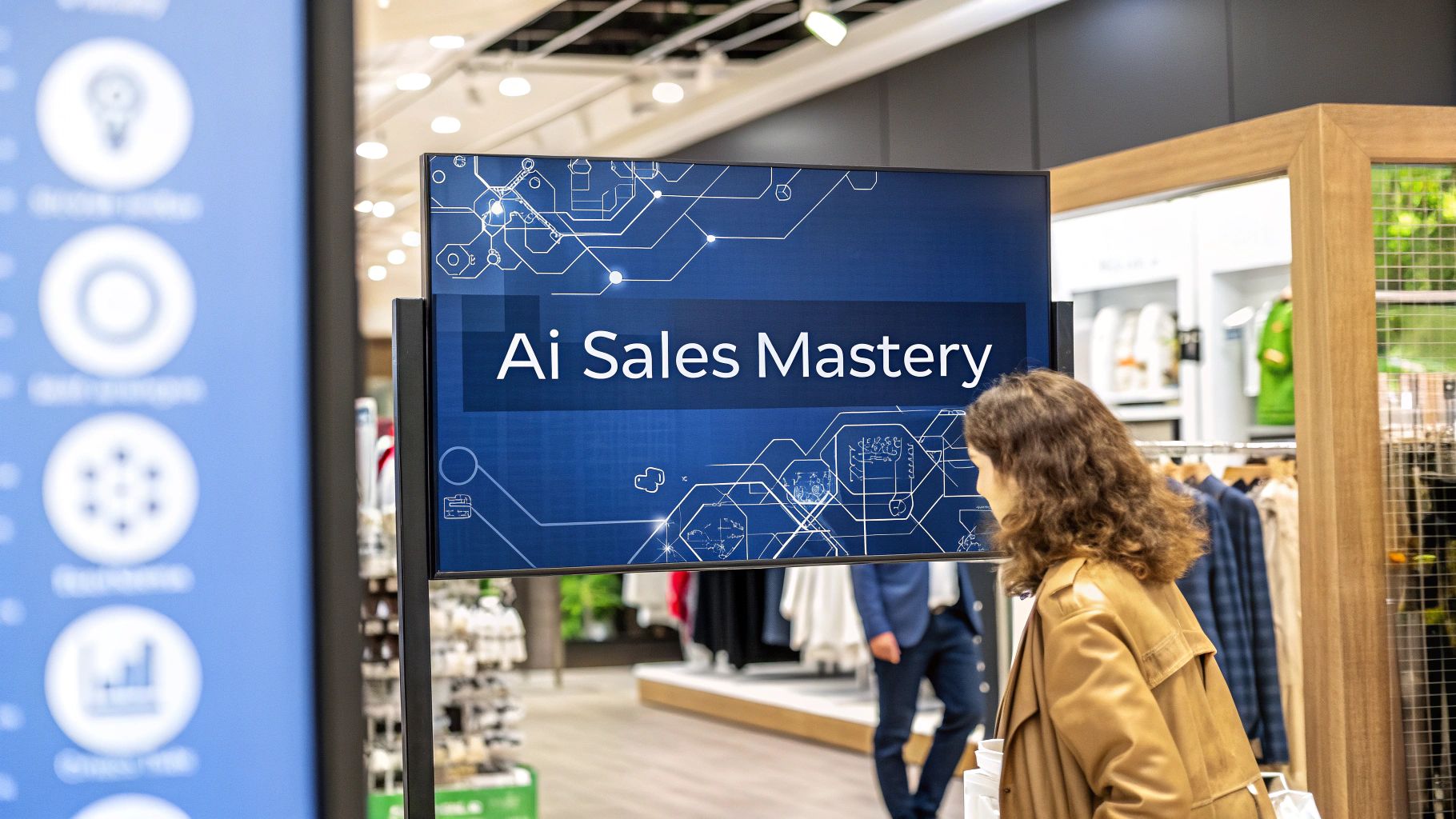Augmented reality isn't just a sci-fi gimmick anymore; it's a real-world tool that’s changing how we shop online. The future of augmented reality in ecommerce is all about closing that frustrating gap between seeing a product on a screen and knowing how it will actually look in your home or on you. It gives people the confidence to finally hit that "buy" button.
What was once a cool novelty is now becoming a must-have feature in the customer's journey.
How AR is Remaking Online Shopping
The biggest headache for online retail has always been the same: you can't touch, feel, or truly see a product before you buy it. That uncertainty is the number one cause of abandoned carts and expensive returns. AR tackles this problem head-on by dropping the showroom right into your living room.
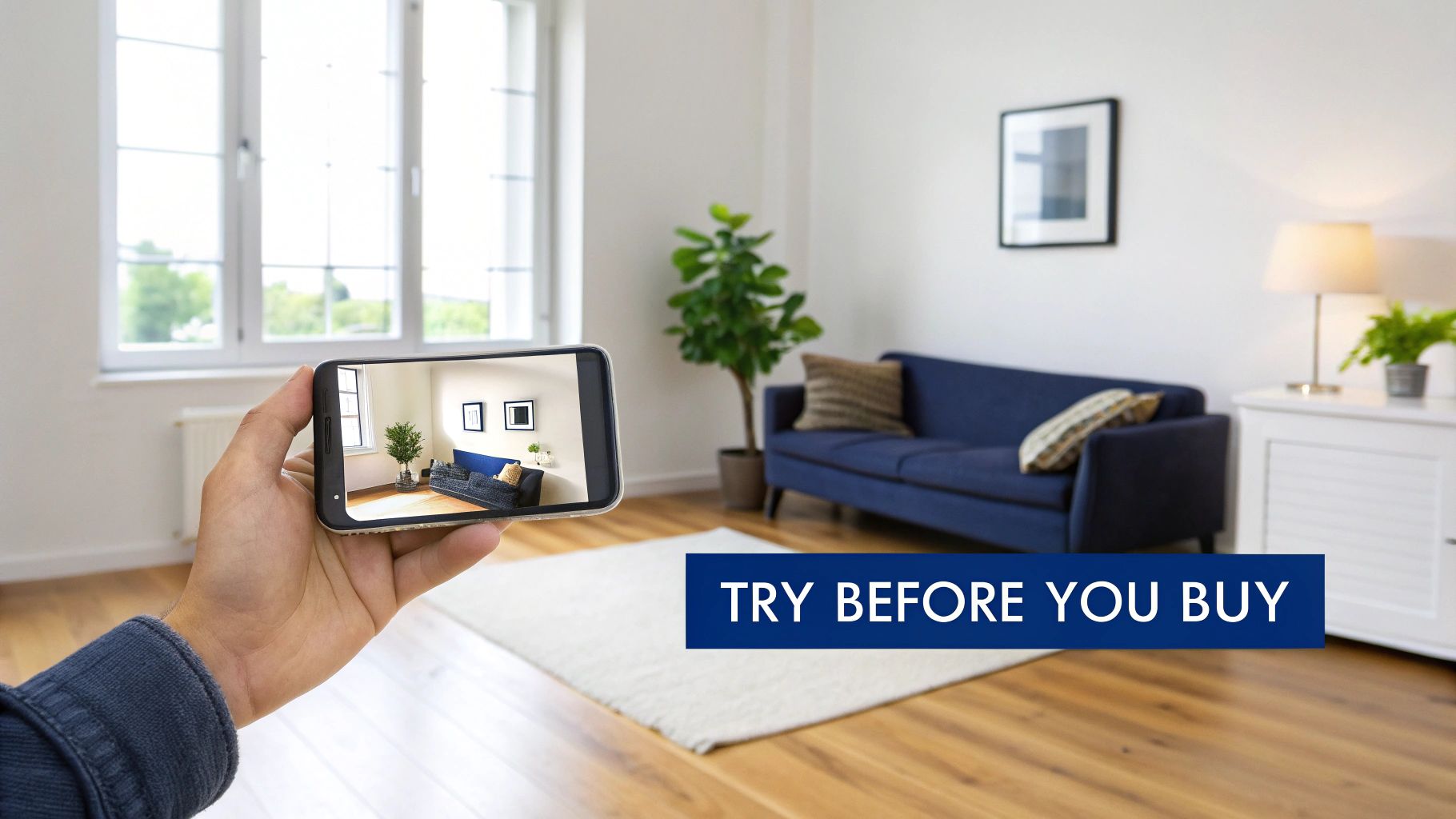
Think of AR as the ultimate shopping assistant. It uses your phone's camera to place a digital 3D model of a product into your real-world space, giving you an interactive preview. It’s a simple concept, but it works wonders for building trust.
Why AR is Catching On So Fast
A few key trends are pushing AR into the mainstream for online stores. The tech itself is getting better and easier to use, and at the same time, shoppers are starting to expect more from their online experience.
-
Shoppers Expect More: People are tired of static product photos. They want to be engaged. A NielsenIQ survey revealed that 61% of consumers say they'd rather shop with brands that offer AR.
-
The Phone in Your Pocket is a Powerhouse: Today's smartphones have the processing power and high-quality cameras needed to run AR apps without a hitch. The hardware is already in everyone's hands.
-
Less Guesswork, Fewer Returns: AR lets people "try before they buy," which takes a huge amount of doubt out of the equation. This naturally leads to more sales and, just as importantly, fewer products being sent back.
AR solves the two biggest questions that hold online shoppers back: "How will this look on me?" and "Will this fit in my space?" When you can answer those questions for a customer, you've built serious buyer confidence.
This trend is picking up steam right here in Canada. By 2025, Canadian shoppers will be in the middle of a retail revolution, with tech like AR completely reshaping the buying process. In fact, data from early 2024 showed 9.3% of Canadian businesses were already using generative AI (a close cousin to AR), and many more are planning to follow. It’s all part of a bigger movement toward tech-driven retail.
You can learn more about Canada's transformation through AI and automation and how it's impacting the market.
How AR is Actually Being Used in Ecommerce Today
Augmented reality isn't just a gimmick anymore. When you get down to it, AR becomes an incredibly practical sales tool by tackling the real, tangible problems customers face when shopping online. Its true power is in how it takes the guesswork out of buying, turning a hesitant "maybe" into a confident "yes."
Let's look at the three biggest ways brands are using AR right now to solve those critical pain points, build trust with shoppers, and, of course, drive more sales. These aren't futuristic concepts; they're delivering real results for businesses today.
Virtual Try-On: Nailing the Perfect Fit
The biggest hurdle for online fashion and beauty has always been obvious: you can't try things on. Customers are constantly asking, "How will this actually look on me?" That single question is the source of endless uncertainty and sky-high return rates that eat away at profits. This is exactly where Virtual Try-On (VTO) technology steps in.
Using just a smartphone camera, VTO overlays a digital version of a product, like glasses, a specific shade of lipstick, or even a jacket, onto your live image. You can see instantly how a pair of sunglasses fits your face or if that bold lipstick colour works with your skin tone, all from your living room.
This is about more than just convenience; it's about building confidence. When a shopper sees a product on themselves, they feel far more secure in their decision. One of the most game-changing applications we're seeing is the rise of virtual fitting room apps, which let customers try on clothing from anywhere, drastically cutting down the chances of a return.
In-Home Product Visualization: See It in Your Space
When it comes to bigger purchases like furniture or home appliances, the nagging questions are all about size and style. "Will this sofa even fit in my living room?" or "Does this coffee machine clash with my kitchen counters?" In-home product visualization gives customers the answers immediately.
Retailers like IKEA have been leading the charge here, with apps that let you place true-to-scale 3D models of their furniture right in your own space. You can literally walk around a virtual armchair, see it from every angle, and check if it matches your curtains.
This simple act of placing a digital product in a real-world context removes the biggest point of friction for big-ticket items. It transforms an abstract product page into a tangible, personalized preview, bridging the gap between browsing and buying.
This kind of interactive experience is fast becoming a key differentiator, especially as Canada’s ecommerce market continues to boom. Projections show the market soaring past $74 billion CAD in 2025, a huge leap from $65.5 billion CAD in 2024. This growth isn't just about more people shopping online; it's driven by better digital experiences where AR is essential for boosting buyer confidence and reducing returns, particularly for clothing, electronics, and home goods. You can dive deeper into Canada’s ecommerce outlook and logistics to get a better sense of these market trends.
Interactive Product Guides and Demos: Beyond the Sale
AR’s usefulness doesn’t stop once the customer clicks "buy." For products that need some setup or have a lot of features, interactive AR guides offer a much more intuitive experience than a dense paper manual ever could.
Imagine pointing your phone at a new espresso machine and seeing digital labels pop up to identify every button and function. Or think about an AR overlay that walks you through assembling flat-pack furniture step-by-step, showing you exactly where each screw goes in real time.
These interactive guides make the post-purchase experience so much better:
-
Less Frustration: They make complicated setups feel simple and straightforward, which means happier customers.
-
Lower Support Costs: When you empower users to solve problems on their own, you get fewer calls to your support centre.
-
Better Product Engagement: Customers who actually understand how to use all the features of a product are far more likely to love their purchase for the long haul.
By extending AR into the ownership phase, brands can build much stronger customer loyalty and ensure that the positive experience continues long after the package has been delivered.
AR Use Cases Across Ecommerce Industries
Different industries are applying AR in unique ways to solve specific customer challenges. This table breaks down how some of the biggest retail sectors are putting the technology to work.
| Industry | Primary AR Application | Key Customer Benefit | Example Brand |
|---|---|---|---|
| Fashion & Apparel | Virtual Try-On for clothing, shoes, and accessories. | Reduces "fit uncertainty" and lowers return rates. | Gucci (Sneakers) |
| Beauty & Cosmetics | Makeup try-on for lipstick, eyeshadow, etc. | Allows personalized colour matching and experimentation. | Sephora |
| Furniture & Home Decor | In-home product visualization to check size and style. | Builds confidence for large, expensive purchases. | IKEA (IKEA Place) |
| Eyewear | Virtual try-on for glasses and sunglasses. | Ensures a perfect fit for face shape without a store visit. | Warby Parker |
| Electronics | Interactive product demos and setup guides. | Simplifies complex features and reduces user frustration. | Samsung |
As you can see, the most successful AR implementations are those that are hyper-focused on solving a genuine problem, making the entire shopping journey smoother and more reliable for the customer.
Understanding the Technology Behind AR Experiences
To really grasp where AR in ecommerce is headed, it’s worth pulling back the curtain to see how the magic actually works. It might look seamless, but every AR experience is a sophisticated dance between several powerful technologies. Think of it like a symphony; each piece of tech has to play its part perfectly to create that immersive feeling for the shopper.
The whole show starts with foundational frameworks, which are essentially the toolkits developers use to build AR features. The two heavyweights in this space are Google's ARCore for Android devices and Apple's ARKit for iPhones and iPads.
These kits do the heavy lifting. They handle complex tasks like motion tracking (knowing where your phone is in the room), environmental understanding (spotting a flat surface like a table or floor), and light estimation. In simple terms, this is what lets a virtual sofa look like it’s actually sitting on your living room floor, complete with realistic lighting and shadows, instead of just floating weirdly in space.
The Platform Dilemma: WebAR vs. Native Apps
One of the biggest forks in the road for any business is deciding how to get its AR experience in front of customers. The choice usually boils down to two main paths: building a downloadable native app or creating a browser-based WebAR experience.
A native app is what you’d download from the App Store or Google Play. It has some real strengths:
-
Performance: Apps can tap directly into a phone's hardware, which means smoother graphics and more complex, responsive interactions.
-
Features: They open the door to a richer set of tools, like push notifications to bring customers back or even offline functionality.
-
The Hurdle: The biggest downside is friction. Getting a customer to commit to downloading yet another app onto their phone can be a tough sell.
On the other side, you have WebAR, which lets AR experiences run right inside a mobile web browser – no download needed.
-
Accessibility: This is its superpower. A customer can jump from a product page to an AR view with a single click.
-
Reach: It works across both Android and iOS without needing to build and maintain two separate apps.
-
Limitations: The trade-off is that WebAR can sometimes be less powerful, which might put a cap on graphical complexity or advanced features.
For a lot of ecommerce brands just starting out, WebAR is the go-to choice. Its low-friction, instant-on nature means more shoppers are likely to actually give it a try.
The Backbone: 3D Models and Backend Systems
An AR experience is empty without high-quality 3D content. Every single product you want to show in AR needs to be painstakingly recreated as a 3D model, often called a "digital twin." This isn't just a flat picture; it's a complete digital replica with precise dimensions, realistic textures, and true-to-life colours.
Creating these digital assets is a specialized craft. It requires skilled 3D artists to build products from the ground up using reference photos and measurements. The quality here is non-negotiable; a cheap or poorly rendered model will instantly shatter the illusion and can even make a customer lose trust in the product.
Behind the scenes, a robust backend system acts as a digital warehouse. It needs to store, manage, and deliver these 3D models to a customer's device in the blink of an eye. When a user taps "View in Your Room," this system ensures the correct file is sent quickly and efficiently.
This infographic shows how these core AR applications work together to create a better shopping journey.
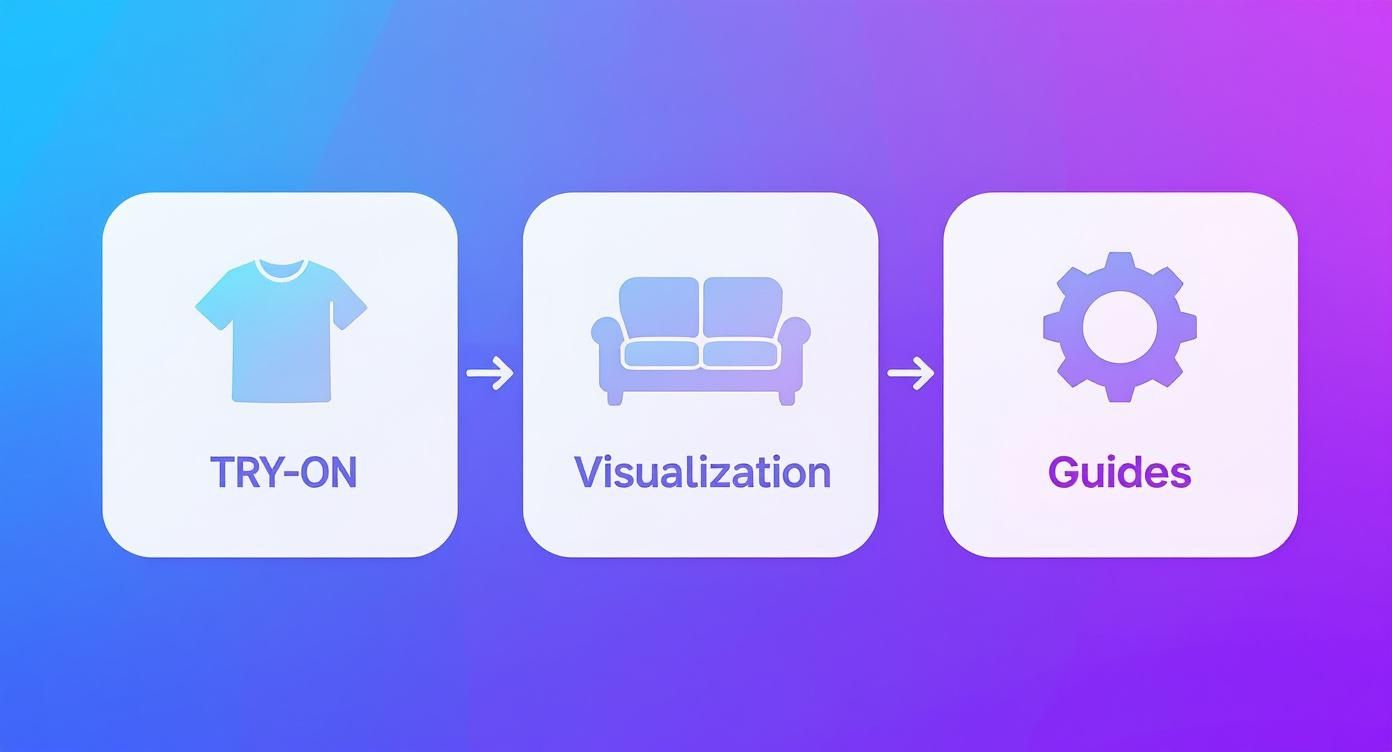
As the visual shows, each AR feature solves a specific problem for the customer, from easing pre-purchase doubts with visualization to offering help after the sale.
The Intelligence Layer: AI and Machine Learning
This is where AR starts to get really clever. Artificial intelligence (AI) and machine learning (ML) are the invisible engines that turn a good AR experience into a great one. They quietly work in the background to make everything feel more real, personal, and intuitive.
AI algorithms help refine the core jobs of AR frameworks, making surface detection sharper and object tracking more stable, even if the user is walking around. This is what keeps that digital chair "locked" to your floor, making the effect far more believable. You can dig deeper into how these technologies connect by exploring the benefits of extended reality.
Beyond stability, ML models can analyse a user's surroundings or even their style to make smart recommendations. Imagine an AR furniture app that notices your wall colour and suggests a sofa that would match perfectly. In the beauty world, AI is the key to accurately mapping a person's facial features, allowing virtual makeup to look stunningly realistic. This intelligent layer isn't just a bonus; it’s a critical piece shaping the future of augmented reality in ecommerce.
How to Measure the ROI of Your AR Investment
So, you're thinking about investing in augmented reality. It’s a smart move, but let’s be honest; it’s not just about the "wow" factor. It's a strategic decision that needs to pay for itself. To make the investment worthwhile, you need a clear, no-nonsense way to measure its success. This means looking past the novelty and zeroing in on the numbers that actually affect your bottom line.
Measuring the return on investment (ROI) for AR isn't just about a spike in sales. It’s a bigger picture that includes hard data alongside some powerful, if less tangible, benefits. By getting your tracking right from the very beginning, you can build a rock-solid case for the future of augmented reality in ecommerce.
Identifying Your Key Performance Indicators
Before you can crunch the numbers on ROI, you need to know what to measure in the first place. AR experiences influence how customers behave in a few predictable ways, which gives us some specific metrics to watch. Think of these KPIs as the pulse of your AR strategy.
Here are the most important ones to keep an eye on:
-
Conversion Rate Lift: This is your most direct proof of success. Simply compare the conversion rate of shoppers who use your AR feature to those who don't. A noticeable jump here is a clear win.
-
Reduction in Product Returns: AR gives customers the confidence to make better decisions. Tracking the return rate for products viewed in AR versus those that weren't can uncover huge cost savings.
-
Increased Engagement Time: How long are people sticking around on product pages with AR? Longer sessions usually mean higher purchase intent and a stronger connection to your brand.
-
Add-to-Cart Rate: This one’s a great indicator of intent. How often do AR users actually add the product to their cart? It shows the AR experience successfully pushed them one step closer to buying.
Focusing on these data points starts to paint a very clear picture of how AR is performing. If you want to build a solid foundation for your tracking, it’s worth exploring an introduction to ecommerce analytics and KPIs.
Calculating the Financial Return
Once you've got your KPIs, you can start connecting them to real dollars and cents. The basic ROI formula is pretty straightforward: (Financial Gain – Cost of Investment) / Cost of Investment.
Let's break that down in an AR context:
-
Financial Gain: This is the extra revenue you bring in from higher conversion rates, plus all the money you save from fewer product returns (think shipping and restocking costs).
-
Cost of Investment: This bucket includes the initial costs for creating 3D models, any software or platform fees, and the work needed to integrate it all with your ecommerce site.
For example, let's say you spend $10,000 to get your AR feature up and running. It ends up generating an extra $25,000 in profit from more sales and fewer returns. Your ROI is a very healthy 150%. This simple calculation turns fuzzy engagement metrics into a concrete business case.
This kind of financial impact is becoming a big deal here in Canada. The AR and VR market in Canada is on track to hit US$1.0 billion in revenue in 2025, and AR software alone is expected to make up US$308.6 million of that. When 71% of consumers say they'd shop more often if a store offered AR, you know there's something there. Some retailers are already seeing up to 40% higher conversion rates. The opportunity is massive. You can discover more insights on the Canadian AR market to see just how fast this is growing.
Don't Overlook the Qualitative Benefits
Not every win shows up on a spreadsheet. The qualitative returns from AR are just as crucial for the long-term health of your brand. Think of these benefits as building a competitive moat around your business.
A few key ones to consider:
-
Stronger Brand Perception: Offering AR makes your brand look innovative, modern, and genuinely focused on the customer experience.
-
Competitive Differentiation: In a crowded market, a slick AR feature can be the one thing that makes you stand out from the competition.
-
Enhanced Customer Confidence: AR takes the guesswork out of online shopping. That leads to happier customers who trust your brand more.
The following table breaks down the most important metrics you'll want to track.
Key Metrics for Measuring AR Performance
This table summarizes the primary KPIs used to evaluate the effectiveness and financial return of an augmented reality implementation in an ecommerce setting.
| Metric | How to Measure | Why It Matters |
|---|---|---|
| Conversion Rate Lift | Compare the conversion rate of users who interact with AR vs. those who don't. | The most direct indicator that AR is driving sales and increasing revenue. |
| Return Rate Reduction | Track the percentage of returned items for products viewed in AR against the site-wide average. | Lower returns translate directly to cost savings on shipping and restocking. |
| Engagement Time | Measure the average session duration on product pages with AR features. | Longer engagement signals higher interest and a stronger connection to the product. |
| Add-to-Cart Rate | Monitor how often AR users add an item to their shopping cart. | A key measure of purchase intent, showing AR effectively moves customers to act. |
| AR Feature Adoption | Track the percentage of page visitors who click to launch the AR experience. | Shows how well the feature is promoted and whether customers find it appealing. |
Tracking these metrics gives you a complete view of performance.
Ultimately, measuring the ROI of your AR investment is a mix of art and science. It's about tracking the right numbers while also appreciating the powerful, long-term impact AR has on how customers feel about your brand.
Your Practical Roadmap for Implementing AR
Bringing augmented reality into your business isn't some far-off, futuristic dream. It's an achievable project when you break it down into clear, manageable steps. Think of it as a journey from an initial idea to a live feature that your customers will love.
We can organize the entire process into four distinct phases. Each stage builds on the last, ensuring you move forward with a solid plan from start to finish.
Stage 1: Strategy and Goal Setting
Before a single line of code is written, it all starts with strategy. This is where you ground your AR ambitions in real business objectives. You need to be crystal clear on what success looks like and what specific customer problem you're trying to solve.
Start by asking the hard questions:
-
Which products are the best fit for AR? Don't try to do everything at once. Focus on items that cause the most headaches for shoppers, like products with high return rates or anything where size and fit are major unknowns.
-
What's our number one goal? Are you aiming to slash returns by 20%? Or maybe boost conversions on certain product pages? Nailing down your key performance indicators (KPIs) right now is absolutely critical for proving value later.
-
Who are we building this for? Knowing your audience’s comfort level with technology will directly influence the design, ensuring the final experience is intuitive and genuinely helpful, not frustrating.
Answering these questions gives you a clear direction and a benchmark to measure your success against.
Stage 2: Creating Your 3D Assets
At the very core of any AR experience are the 3D models of your products. These "digital twins" have to be high-quality, perfectly scaled, and incredibly realistic to work. A cheap-looking or inaccurate model will instantly break the illusion and could even damage a customer's trust in your brand.
You basically have two ways to get this done:
-
In-House Creation: If you're lucky enough to have talented 3D artists on your team, you can produce the models yourself. This gives you total control over the quality and style, but it demands specialized skills and software.
-
Outsourcing to Specialists: Many businesses find it more efficient to partner with agencies or freelancers who live and breathe photorealistic 3D modelling for e-commerce. It’s often the quickest way to get expert results without the internal overhead.
No matter which path you take, the goal is the same: create digital replicas so good they're almost indistinguishable from the real thing.
A successful AR implementation is built on a foundation of exceptional 3D content. The more realistic and accurate your product models are, the more confidence you will build in your customers, directly influencing their decision to purchase.
Stage 3: Choosing and Integrating the Tech
With your strategy locked in and 3D models underway, it's time to pick the right technology to bring it all to life. The big decision here is whether to use an existing AR platform or go for a custom-built solution.
Ready-made platforms can seriously speed up development with their pre-built tools. They often have handy integrations for popular e-commerce systems like Shopify, which can make the setup process much smoother. For businesses wanting a faster and more budget-friendly way to get started, these platforms are a fantastic option.
A custom build, on the other hand, gives you complete creative freedom to tailor the experience precisely to your brand. This route is perfect for companies with unique needs or those determined to create a signature user experience that stands out. If your store is on a platform like Shopify, a custom integration might mean developing your own app. For a deeper look at what that entails, check out this guide to Shopify app development.
Stage 4: Launch and Optimization
Getting your AR feature live is a huge milestone, but it's really just the beginning. The final stage is all about putting it in front of customers and using real-world data to make it even better. A great launch needs a coordinated promotional push so shoppers actually know this cool new tool is available.
Your launch plan should cover:
-
Obvious Calls-to-Action (CTAs): Place big, clear "View in Your Room" or "Try It On" buttons right on your product pages where no one can miss them.
-
Marketing Buzz: Shout about it from the rooftops! Announce the new feature in your email newsletters, on social media, and maybe even with a few paid ads to generate excitement.
-
Gathering Feedback: Pay close attention to how people are using it and actively ask for their opinions. This will show you what's working and where the sticking points are.
After the launch, keep a close eye on your data. Track your KPIs to see the real impact on sales and returns, and use those insights to refine the experience, expand your AR catalogue, and prove the long-term value of your investment.
What's Next for AR in Commerce? Future Trends and Current Hurdles
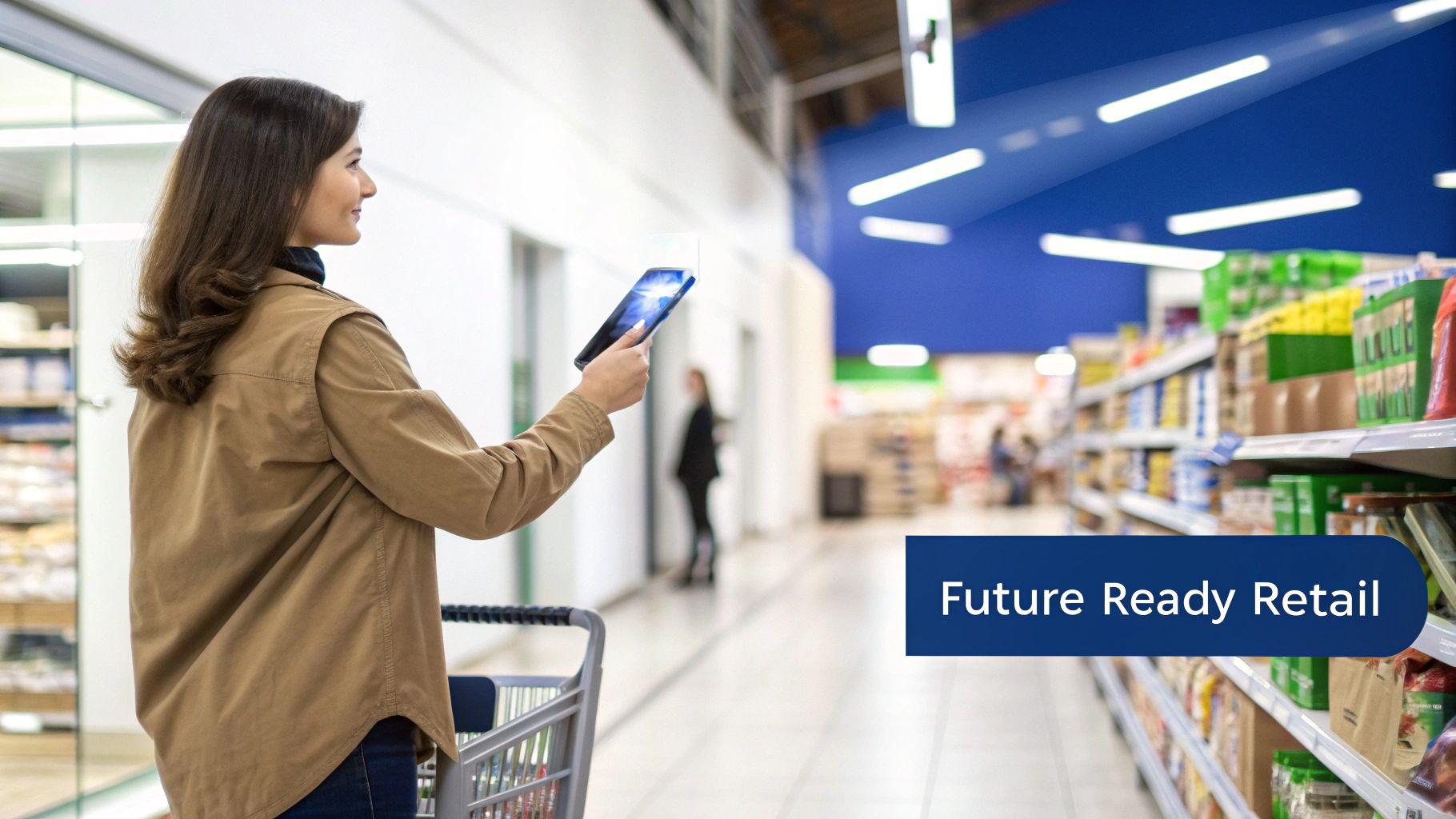
Augmented reality is already proving its worth in ecommerce, but this is just the beginning. To really get ahead, we need to look at what's coming down the pipe while also being realistic about the roadblocks that still exist today. The future of augmented reality in ecommerce is all about solving today’s problems to seize tomorrow's opportunities.
One of the biggest hurdles right now is simply making the experience smooth. If an AR feature is clunky, slow, or confusing, it's worse than having no feature at all. It just frustrates people. Brands have to nail the user interface, ensuring it runs perfectly on the vast mix of smartphones and browsers their customers are using.
Then there's the challenge of creating all the 3D content. Building a huge library of realistic digital products isn't cheap or easy. It takes a significant investment in time and specialized skill, which can put it out of reach for many businesses.
The Next Wave of Immersive Retail
Looking ahead, a few key trends are lining up to weave AR even more deeply into our shopping routines. The most exciting one? The mash-up of AR with artificial intelligence.
Just picture it: an AI shopping assistant that uses your phone's camera to figure out your personal style, then projects perfectly matched clothing recommendations right onto your body in real-time. This is where generative AI comes in, as it’s a game-changer for content creation. You can dive deeper into how generative AI is changing the future of 3D design to see just how big its impact will be.
The convergence of AR and AI will transform product discovery from a manual search into a personalized, guided experience. It's about moving from showing what's possible to showing what's perfect for you.
On top of that, behind-the-scenes tech advancements are going to be crucial. Two developments, in particular, will make a huge difference:
-
The Rollout of 5G: With its lightning-fast speeds, 5G will kill the lag that can sometimes plague AR. This means complex, high-detail AR experiences will load in a snap without murdering your phone's battery.
-
Edge Computing: This is about processing data closer to you, rather than on some far-off server. For AR, edge computing means interactions will become incredibly responsive and feel completely seamless.
As these technologies become more common, they'll smooth out the last of the rough edges, making AR feel less like a novelty and more like a natural, essential part of how we shop. The businesses that can tackle today's challenges while keeping a sharp eye on these future trends are the ones that will truly lead the way.
Common Questions About AR in Ecommerce
Jumping into augmented reality naturally brings up a lot of questions: about the cost, the technology, and what it actually does for the bottom line. If you're looking at the future of augmented reality in ecommerce, getting straight answers is the first step to making a smart investment. Let's tackle some of the most common things we hear from business owners.
Many people assume AR is just for the big players with deep pockets, but that’s not the full picture anymore. The technology can feel complicated, but breaking it down shows just how practical and beneficial it can be.
Is AR Technology Too Expensive for a Small Business?
Let's be honest: the biggest hurdle for most businesses is the cost of creating 3D models of their products. The good news is that these costs are coming down, and modern platforms offer more affordable, scalable solutions that don’t demand a huge upfront spend.
The best way to approach it is to start small. Don't try to digitize your entire catalogue at once. Pick a handful of your best-selling products, get them into AR, and then watch the numbers closely. See how it affects sales and, just as importantly, your return rates. This way, you’re making a manageable investment and using your own data to prove the concept before you scale up.
Do My Customers Need a Special App to Use AR?
Not anymore, and this is a huge deal. A few years ago, the answer was yes, but today’s WebAR technology changes everything. Now, customers can launch an AR experience right from their mobile web browser, whether it's Chrome, Safari, or something else. All it takes is a simple button on your product page.
This shift to WebAR is what makes the experience so seamless. It’s instantly accessible and dramatically increases the number of people who will actually use it. When a customer can go from browsing to visualizing in a single click, the adoption rates are incredible.
This easy access is a major reason why AR has moved from a neat gimmick to a genuinely practical sales tool for businesses of all sizes.
How Exactly Does AR Reduce Product Returns?
AR directly tackles the number one reason for returns: the product just wasn't what the customer expected. It closes that painful gap between what someone sees on their screen and what shows up at their door.
-
In fashion, virtual try-on gives a far better sense of fit and style. It helps answer the all-important question, "How will this really look on me?"
-
In home decor, seeing a sofa in your actual living room confirms it’s the right size, shape, and colour before you deal with the headache of shipping.
By setting realistic expectations and building a customer's confidence before they hit "buy," AR massively lowers the odds of a return. This doesn't just save you a fortune on reverse logistics; it also leads to happier customers who trust your brand and come back for more.
Ready to explore how AR can transform your ecommerce store? The team at Cleffex Digital Ltd specializes in creating custom software solutions that solve real business challenges. Learn more about our development services and start your project today.
